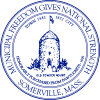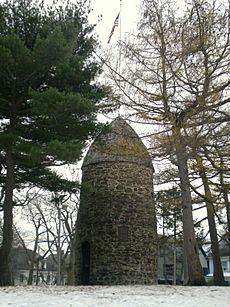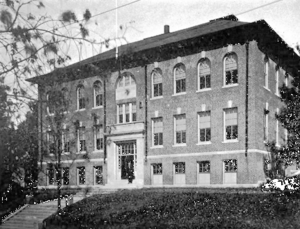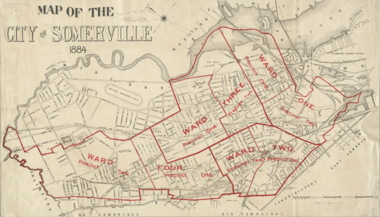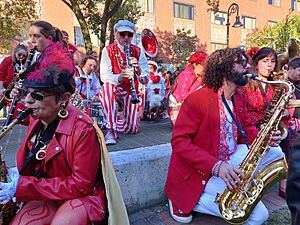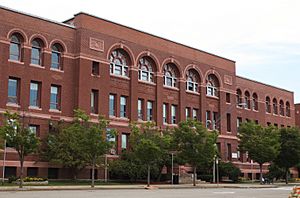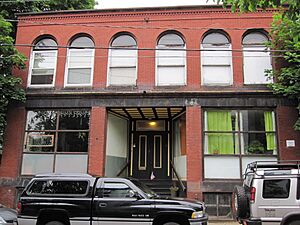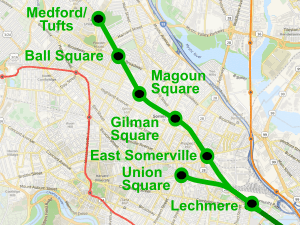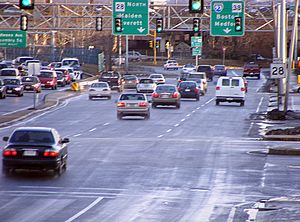Somerville, Massachusetts facts for kids
Quick facts for kids
Somerville, Massachusetts
|
||
|---|---|---|

Davis Square, Somerville
|
||
|
||
| Motto(s):
"Municipal Freedom Gives National Strength"
|
||

Location in Middlesex County in Massachusetts
|
||
| Country | ||
| State | ||
| County | Middlesex | |
| Region | New England | |
| Settled | 1629 | |
| Purchased | 1639 | |
| Incorporated (town) | 1842 | |
| Incorporated (city) | 1872 | |
| Government | ||
| • Type | Mayor–council | |
| Area | ||
| • Total | 4.22 sq mi (10.94 km2) | |
| • Land | 4.12 sq mi (10.68 km2) | |
| • Water | 0.10 sq mi (0.26 km2) | |
| Elevation | 12 ft (4 m) | |
| Population
(2020)
|
||
| • Total | 81,045 | |
| • Density | 19,652.04/sq mi (7,588.17/km2) | |
| Demonym(s) | Somervillian, Villen | |
| Time zone | UTC−5 (Eastern) | |
| • Summer (DST) | UTC−4 (Eastern) | |
| ZIP Codes |
02143–02145
|
|
| Area code(s) | 617 / 857 | |
| FIPS code | 25-62535 | |
| GNIS ID | 0612815 | |
Somerville is a busy city in Middlesex County, Massachusetts. It is just northwest of Boston and north of Cambridge. In 2020, about 81,045 people lived there.
Somerville is a small city, about 4.12 square miles (10.7 square kilometers). This makes it the most crowded city in New England. It is also one of the most crowded cities in the entire country.
Somerville started as a town in 1842. It separated from Charlestown then. In 2006, The Boston Globe newspaper called Somerville the best-run city in Massachusetts. The city has won the All-America City Award three times. Tufts University has a campus that sits on the border of Somerville and Medford.
Contents
History of Somerville
Early Days and Settlement
The land where Somerville is now was first settled by Europeans in 1629. It was part of a larger area called Charlestown. In 1629, a group of 100 Puritans came from Salem. They were led by Thomas Graves. They wanted to prepare the area for more Puritans coming from England.
The first European settler recorded in Somerville was John Woolrich in 1630. He was a trader who settled near what is now Dane Street. More settlers came and lived near Union Square. In 1639, colonists officially bought the land from the Squaw Sachem of Mistick. By 1775, about 500 people lived there. Most of the land was used for farming and grazing animals.
John Winthrop, the first governor of the Massachusetts Bay Colony, got 600 acres of land in 1631. This land was called Ten Hills Farm. It was named for the ten small hills on the property. Winthrop farmed and raised cattle there. He also launched the first ship in Massachusetts, the "Blessing of the Bay". This ship helped with trading and later became a patrol boat. The "Ten Hills" neighborhood still has this name today.
Early settlers built roads to find more land and trade with Native American tribes. Washington Street was probably the first road, built in the 1630s. It went from Sullivan Square to Harvard Square. It was first called the "Road to Newtowne." Later, Somerville Avenue was known as "Milk Row." Farmers used it to take milk to markets in Charlestown and Boston.
Broadway was likely the second main road, built in 1636. It ran from the Charlestown Neck to Arlington. Broadway became a busy street after horse-drawn trolleys started using it in 1858.
Somerville's Role in the Revolutionary War
Somerville played a big part in the start of the American Revolutionary War. In 1774, British soldiers took gunpowder from a building here. This event, called the Powder Alarm, made many people angry. It helped lead to the war.
The Old Powder House was first a windmill in the early 1700s. In 1747, it became a place to store gunpowder. It held the most gunpowder in Massachusetts. General Thomas Gage, the British military governor, wanted to stop a war. He decided to secretly remove military supplies.
On September 1, 1774, British soldiers went to the Powder House. They took all the gunpowder. This made people think war had started. Thousands of militiamen rushed towards Boston and Cambridge. This event was like a practice for the Battles of Lexington and Concord seven months later.
After the Powder House raid, colonists hid their weapons in Concord. When General Gage found out, he planned to take them by force. On April 18, 1775, Paul Revere and William Dawes rode to warn people. Paul Revere rode through what is now East Somerville. He saw British officers and escaped. His warning helped the militia get ready for battle. This started the American Revolution.
The British army later retreated through Somerville. A fight happened near Union Square. A 65-year-old minuteman named James Miller was killed. He famously said, "I am too old to run."
Somerville was important during the Siege of Boston. Prospect Hill became a key spot for the Continental Army. It was called the "Citadel." It is believed that on January 1, 1776, the Grand Union Flag flew here for the first time. This was the first official American flag.
Growing into a City
After the Revolutionary War, Somerville grew slowly. New businesses like brickmaking and dairy farming started. Better transportation helped the area grow. The Middlesex Canal opened in 1803. New roads like Medford and Beacon streets were built.
The Fitchburg Railroad came in 1841. This led to new factories and homes. By the early 1840s, over 1,000 people lived in Somerville.
People in Somerville felt they were not getting enough from Charlestown's government. They paid taxes but had few schools or churches. In 1842, they asked to become a separate town. On March 3, 1842, Somerville became a new town. The name "Somerville" was chosen. It was not named after a person, but was a "purely fanciful name."
Somerville's population grew six times between 1842 and 1870. Many immigrants came to work in the booming industries. Brick manufacturing was very important. Somerville made millions of bricks each year. Other factories made steam engines, glass, and iron.
In 1872, Somerville officially became a city. The population grew from 15,000 to 90,000 people. Meatpacking became the main industry. Somerville was even called "The Chicago of New England." Its location near Boston and good transportation made it a great place for businesses.
Irish immigrants moved to Somerville to work in the brickyards and on the railroad. Older residents moved from Boston and Charlestown for a quieter life.
Between 1915 and 1930, Somerville's industries changed. Meatpacking and food distribution were still important. In 1925, the McGrath Highway was built. In 1926, the Ford Motor Company built a car plant in Assembly Square. Car making became Somerville's most important industry.
By 1930, most Somerville residents were immigrants or had immigrant parents. The city's population reached its highest point in 1940, with over 105,000 residents.
Changes and Comeback
After World War II, Somerville's industries and population started to shrink. More people used cars. Streetcar lines were removed, and train service stopped. This made it harder for people to get around without a car.
New highways were built, sometimes tearing down neighborhoods. The Brickbottom area was cleared for a highway. Interstate 93 also caused homes to be torn down.
Factories moved away, looking for cheaper land. The Ford Motor Plant in Assembly Square closed in 1958. This hurt the local economy. By the late 1970s, Somerville was losing people, money, and jobs.
However, Somerville started to get better in the late 1900s. The Red Line subway reached Davis Square in 1984. This helped bring new businesses and improvements to the area. At first, businesses didn't boom right away. But as the Boston area economy improved, Davis Square became very lively.
The growth of technology companies in the 1990s also helped Somerville. More jobs in Boston and Cambridge meant more demand for homes in Somerville. The city became known for its active arts community. It was named the best-run city in Massachusetts in 2006. Today, people are working to keep Somerville's "small-town" feel. They support local businesses and public transportation.
Geography of Somerville
Somerville covers about 4.2 square miles (10.9 square kilometers). Most of this is land, with a small amount of water. It is next to Cambridge, Medford, Everett, Arlington, and Charlestown. The Mystic River is to its north.
Long ago, glaciers formed hills across Somerville. These are known as the "Seven Hills" of Somerville:
- Central Hill
- Clarendon Hill
- Cobble Hill
- Ploughed Hill (or Mount Benedict)
- Prospect Hill (or Mount Pisgah)
- Spring Hill
- Winter Hill
These hills offer great views of Boston. The Mystic River to the north and Alewife Brook to the west also form natural borders.
Early Somerville had farms and grazing areas. Later, factories and railroads changed the land. Some rivers were filled in to make space for train yards and other large buildings.
Squares and Neighborhoods
Somerville does not have one main downtown area. Instead, it has many business centers called "squares." These squares grew up around train and streetcar stops. The hills in Somerville also helped decide where roads and businesses would develop.
Each square has its own feel. Davis Square is known for its nightlife, music, and theaters. Assembly Square has large stores and easy highway access.
Here are some of Somerville's main squares and neighborhoods:
- Assembly Square
- Ball Square
- Brickbottom
- Clarendon Hill
- Davis Square
- Duck Village
- East Somerville
- Gilman Square
- Inner Belt District
- Magoun Square
- Nunnery Grounds (Mount Benedict)
- Powder House Square
- Prospect Hill (part of Union Square)
- Spring Hill
- The Aves (also called "The States")
- Teele Square
- Ten Hills
- Tufts
- Union Square
- Wilson Square (formerly Oak Square)
- Winter Hill
People of Somerville
| Historical population | ||
|---|---|---|
| Year | Pop. | ±% |
| 1850 | 3,540 | — |
| 1860 | 8,025 | +126.7% |
| 1870 | 14,685 | +83.0% |
| 1880 | 24,933 | +69.8% |
| 1890 | 40,152 | +61.0% |
| 1900 | 61,643 | +53.5% |
| 1910 | 77,236 | +25.3% |
| 1920 | 93,091 | +20.5% |
| 1930 | 103,908 | +11.6% |
| 1940 | 102,177 | −1.7% |
| 1950 | 102,351 | +0.2% |
| 1960 | 94,697 | −7.5% |
| 1970 | 88,779 | −6.2% |
| 1980 | 77,372 | −12.8% |
| 1990 | 76,210 | −1.5% |
| 2000 | 77,478 | +1.7% |
| 2010 | 75,754 | −2.2% |
| 2020 | 81,045 | +7.0% |
| 2023* | 80,407 | −0.8% |
| * = population estimate. Source: United States Census records and Population Estimates Program data. Source: |
||
Somerville has grown a lot since the Red Line subway opened in 1985. Many college students and young professionals live here. This is because of nearby schools like Harvard University, Lesley University, Massachusetts Institute of Technology, and Tufts University.
The city is also home to families with backgrounds like Irish American, Italian American, Greek American, and Portuguese American.
In 1997, Utne Reader magazine called Davis Square one of the hippest places in the U.S. Somerville has many artists and is known for its lively arts community.
Population in 2020
In 2020, Somerville had 81,045 people and 34,523 households. The city is very crowded, with about 19,657 people per square mile.
The people in Somerville come from many different backgrounds:
- 74.3% White
- 5.0% Black or African American
- 0.2% American Indian or Alaska Native
- 9.4% Asian
- 6.9% Two or more races
About 12.3% of the population was Hispanic or Latino. Somerville offers translation services in Spanish, Portuguese, Haitian Creole, and Nepali.
The average household had 2.25 people. The average family had 2.83 people. The median income for a household was $108,896 in 2021. About 10.4% of residents lived below the poverty line.
Economy and Jobs
Somerville has a rich history of inventions and businesses. Archibald Query invented Marshmallow Fluff here. The first Economy Grocery Store, which became Stop & Shop, started in Somerville in 1914. Later, Steve's Ice Cream and Bertucci's restaurants also began in Davis Square.
Today, companies like Gentle Giant Moving Company, Formlabs, and Candlewick Press are based in Somerville.
In 2016, Mass General Brigham, a large healthcare system, moved its main office to Assembly Square. Many other companies have also opened offices there and in Union Square.
Main Employers
Here are some of the biggest employers in Somerville:
| Rank | Employer | Employees (# of) |
|---|---|---|
| 1 | Tufts University | 2,193 |
| 2 | ABM Industries | 2,000 |
| 3 | Cambridge Health Alliance | 1,014 |
| 4 | Somerville School Department | 854 |
| 5 | City of Somerville | 695 |
| 6 | Angelica Textiles | 546 |
| 7 | Federal Realty Investment Trust | 510 |
| 8 | Gentle Giant | 375 |
| 9 | Rogers Foam Corporation | 300 |
| 10 | Van der Weil | 300 |
Arts and Culture
Davis Square is home to the Somerville Theatre. This theater hosts the Independent Film Festival of Boston every spring. You can also find live music at Union Tavern and the Crystal Ballroom.
Somerville hosts Porchfest every May. About 200 bands play music on residents' porches all over the city. This festival started in 2011.
Many artists have studios in former factory buildings. The Brickbottom Artists Building and Joy Street Studios are examples. They often have open studio events. Starlab Studios and Artisan's Asylum also provide spaces for artists and makers.
The Somerville Public Library has three locations. The Somerville Arts Council and Somerville Open Studios hold yearly events to celebrate local art.
Since 2006, an annual Fluff Festival celebrates the invention of Marshmallow Fluff in Somerville. It has vendors, activities, and entertainment.
Bobby "Boris" Pickett, who wrote and sang the famous Halloween song "Monster Mash", was from Somerville.
Places to Visit
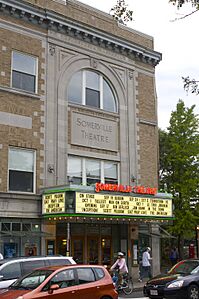
Dilboy Stadium
George Dilboy Memorial Stadium is a public stadium in Somerville. It is home to the Boston Renegades women's tackle football team. The Boston Breakers women's soccer club also played here. The stadium is named after George Dilboy, a World War I hero.
Historic Places
Somerville has 84 sites listed on the National Register of Historic Places. These include old houses, libraries, and churches. They are important landmarks in the city.
Somerville Museum
The Somerville Museum keeps items that tell the story of the city. It has exhibits about Somerville's history and art. You can find it at 1 Westwood Road.
Parks and Recreation
The Somerville Community Path is a paved trail for walking and biking. It runs from Lowell Street to the Cambridge border near Davis Square. It connects to other trails like the Minuteman Bikeway. People hope to extend it to Lechmere Square. This would connect it to the Charles River Bike Paths.
In 2013, work began to extend the path from Cedar Street to Lowell Street. This part was finished in 2015. As of 2010, Somerville has 63 parks, playgrounds, fields, and community gardens.
In 1909, Somerville started offering supervised playgrounds for children in the summer. The Recreation Department was officially created in 1917. It now offers many activities for all ages. These include summer playgrounds, sports leagues, theater groups, and a Senior Citizens Club.
Education in Somerville
The School Committee manages Somerville's schools. It has seven elected members, plus the Mayor and the President of the Board of Aldermen. The budget for schools is approved by both the School Committee and the Board of Aldermen.
The Somerville Center for Adult Learning Experiences is also part of the school district.
Tufts University is mostly located in Medford, but part of its campus is in Somerville. The city line runs right through the Tufts campus. Tufts provides many jobs for local residents. It also has community service projects that help the city.
Somerville Public Schools
Somerville Public Schools (SPS) has ten schools. They serve students from pre-kindergarten to secondary schools. Most schools go from kindergarten through 8th grade. About 4,691 students attend Somerville Public Schools.
- Somerville High School
- East Somerville Community School
- Arthur D. Healey School
- John F. Kennedy School
- Benjamin G. Brown School (K–5)
- West Somerville Neighborhood School
- Albert F. Argenziano School
- Winter Hill Innovation Community School
- Michael E. Capuano Early Childhood Center (pre-kindergarten)
- Next Wave/Full Circle (6–12 grades)
- Edgerly Education Center
The East Somerville Community School was rebuilt after a fire in 2007. It reopened in 2013. Somerville High School also had major renovations from 2012 to 2021.
The Winter Hill school closed in 2023 because of safety concerns. Students and staff moved to the Edgerly building.
Somerville High School
Somerville High School (SHS) is next to Somerville City Hall. It is located at 81 Highland Avenue.
SHS offers a vocational program (CTE), music, and sports. About 1,215 students attend the school. Students are good at math and science (73% proficient) and English and history (83% proficient). There are 10 students for every teacher. The school is in the top 20% of schools in Massachusetts. Its graduation rate is 89.9%.
In 2021, the student population was 45% Hispanic or Latino, 32% White, 14% African American, 8% Asian, and 1% other. Many students (54.6%) do not have English as their first language. Also, 48.1% of students are from low-income families.
SHS sports teams play at Dilboy Stadium. This stadium is about 2.5 miles (4 kilometers) from the school. The hockey team plays at Veterans Memorial Rink.
The school has a student theater group called Highlander Theatre Company. It also has a FIRST Robotics Competition team, FRC 6201 The Highlanders.
In 2023, the school's practice field was named after Phil Reavis. This is the first public space in Somerville named after an African American.
Higher Education
Tufts University is a major university with a campus in Somerville. Lincoln Technical Institute also has a campus here. Lesley University has a campus near Porter Square that extends into Somerville.
Media and News
Somerville has several news sources:
- Somerville Community Access Television
- The Boston Globe
- The Transcript & Journal
- The Somerville News Weekly (an online blog)
- The Somerville Times (newspaper)
- Scout Somerville (magazine)
The public radio show Living on Earth is recorded in Davis Square. Candlewick Press, a big children's book publisher, is also in Somerville.
City Services
Transportation
Somerville was built to be easy to get around without a car. Its neighborhoods are designed for walking and public transit. The MBTA provides public transportation.
Trains and Subways
Somerville has seven MBTA subway stations:
- Davis station on the Red Line
- Assembly station on the Orange Line
- [[{{{station}}} (MBTA station)|{{{station}}}]], [[{{{station}}} (MBTA station)|{{{station}}}]], [[{{{station}}} (MBTA station)|{{{station}}}]], [[{{{station}}} (MBTA station)|{{{station}}}]], and [[{{{station}}} (MBTA station)|{{{station}}}]] on the Green Line.
Davis station opened in 1984, and Assembly in 2014. The Green Line stations opened in 2022 as part of a new extension. Nearby stations like Porter Square station and Sullivan Square station are also close to Somerville's borders.
Roads
Even though many people in Somerville don't drive alone to work, several major roads pass through the city.
McGrath Highway is a main north-south road (Massachusetts Route 28). It was built in 1928 to make travel faster. In the 1950s, parts of it were raised. This cut off some neighborhoods from the rest of the city. Later, Interstate 93 was built, which made McGrath Highway less important. Today, parts of the elevated highway are old and need repair. There are plans to tear down some sections and build a new road with bike lanes and sidewalks.
Northern Expressway (Massachusetts) also runs through Somerville. It separates neighborhoods like Ten Hills and Assembly Square. This large elevated highway was finished in the early 1970s. It carries traffic in both directions and also separates East Somerville from Charlestown.
Walking and Biking
Somerville is great for walking and biking. In 2013, 7.8% of people biked to work. This made Somerville fifth among U.S. cities for biking. Almost half of Somerville commuters (49.8%) walk, bike, or use public transit. Somerville has Bluebikes (bike-sharing) stations.
The Somerville Community Path is a path for walking and biking. It follows an old railroad line. It is lit at night and cleared of snow in winter.
Buses
Somerville has a lot of bus riders. Nearly 40,000 people ride buses through Somerville every day. There are 15 MBTA bus routes in the city.
Emergency Services
The Somerville Fire Department (SFD) protects the city. It has 152 professional firefighters. They work from five firehouses. They operate five engine companies, three ladder companies, and one rescue company. Emergency Medical Services are provided by Cataldo Ambulance Service.
Waste Services
The city provides trash, single-stream recycling, yard waste, and hazardous waste pickup for homes with six or fewer units. They also offer textile recycling pickup. Recycling materials go to a processing facility in nearby Charlestown.
Notable People
- James E. Barlow, civil engineer
- Léone Boudreau-Nelson, phonetician
- Robert A. Bruce, cardiologist
- Mike Capuano, former U.S. Representative and mayor
- Richard Carle, actor
- Gosder Cherilus, NFL player
- Neil Cicierega, musician and animator
- Hal Clement, author
- Hal Connolly, Olympic gold medalist
- George Dilboy, Medal of Honor winner
- Henry F. Gilbert, music composer
- Nick Gomez, film director
- Henry Kimball Hadley, composer and conductor
- Henry Oliver Hansen, raised the first flag at Iwo Jima
- Hazel Heald, pulp fiction writer
- Arthur Daniel Healey, U.S. Representative
- Alan Hovhaness, composer
- James "Hutch" Hutchinson, musician
- Jake Kilrain, boxer
- Howie Long, NFL Hall of Famer and actor
- Martha Perry Lowe, poet and activist
- Peter Mamakos, actor
- Patricia Head Minaldi, judge
- Connie Morella, U.S. Representative
- Randall Munroe, cartoonist and writer
- Jack Parker, hockey coach
- Bobby Pickett, composer of "Monster Mash"
- Harry Nelson Pillsbury, chess champion
- Alfred M. Pride, Navy admiral
- Archibald Query, inventor of Fluff
- Phil Reavis, Olympic high jumper
- Charles Revson, founder of Revlon
- Reverend Leonard Grimes, abolitionist
- Alex Rocco, actor
- Paul Ryan, comic artist
- Daniel Alfred Sanborn, surveyor
- John Shea, playwright
- Paul Sorrento, former Major League Baseball player
- Pie Traynor, Baseball Hall of Famer
- Daniel Chapman Stillson, inventor of the pipe wrench
- The Sturniolo Triplets, YouTubers
- David Foster Wallace, author
- Barbara Weeks, actress
- Eliza Trask Hill, women's suffrage leader
- Aline van Barentzen, classical pianist
Sister Cities
Somerville has "sister cities" around the world. These are cities that partner together for cultural exchange.
See also
 In Spanish: Somerville (Massachusetts) para niños
In Spanish: Somerville (Massachusetts) para niños


